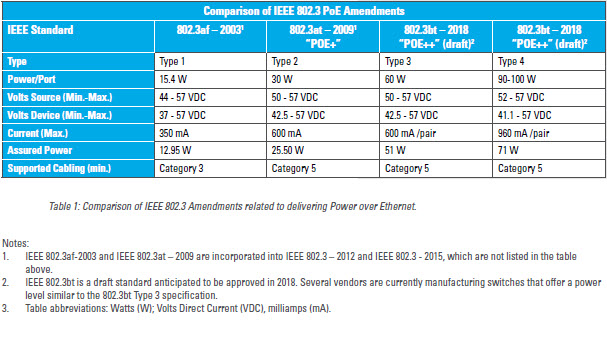Power over Ethernet (PoE) was introduced in 2003. The basic concept is to deliver power over the network connection to end devices, eliminating the need for a separate power connection. Currently deployed PoE delivers up to 25.5 Watts of power to equipment. PoE powers technology such as Voice over Internet Protocol (VoIP) desk phones, wireless access points (WAPs) and basic security cameras.
The enhanced PoE draft amendment, IEEE 802.3bt-2018, proposes two additional types or power ranges, for 60 Watts and up to 100 Watts per connection, thus extending the possibilities to power other end-devices, such as high bandwidth WAPs, pan-tilt-zoom security cameras, access control systems and IoT sensors.
The table below lists some of the technical differences for the various network power standard amendments. Note that each progressive amendment introduces more power to the end-device.

Deploying PoE requires a network switch or a separate in-line power injector to introduce power into the network connection. Network switches that support Type 1 and Type 2 PoE may need to be upgraded to support higher power Type 3 and Type 4 PoE. The power supply in PoE switches is much higher wattage than power supplies for switches that do not support PoE, and consequently, the power connection to the switch is higher power.
Additionally, when PoE powers VoIP phones, a uninterruptable power supply (UPS) and battery backup are typically installed in line with the switch to maintain phone circuits during power outages. Higher power PoE will require a higher capacity UPS and batteries to maintain the same runtime. The switch, UPS and battery backup will also weigh more as compared to a non-PoE switch, which means the rack selected to support the IT equipment needs to be able to handle the additional weight.
PoE will transmit on existing Category 5e Unshielded Twisted Pair (UTP) cabling, but when using Type 4, you may need to adjust bundling size because of the additional heat from the higher power connection. PoE applications are covered in Article 725 of the 2017 National Electric Code (NEC). Table 725.144 of the NEC provides guidance for bundle size based on the size of the conductor and temperature rating of the cable. For example, for an ambient air temperature of 86° Fahrenheit (30° Celsius), Category 5e UTP cable constructed of 24 American Wire Gauge (AWG) conductors and rated for 60°C would be limited to bundle sizes of 38 to 61 cables.
So, a bundle of 48 cables from a typical 2U patch panel would not need to be modified, but a larger bundle of 72 cables or 96 cables would need to be broken into smaller bundles. This means you may also need to space bundles in cable managers and pathways to maintain better airflow around bundles to remove heat.
To learn more about technologies that will affect your enterprise network and best practices for supporting them in your premise networks, download a complimentary white paper.
David Knapp, Product Marketing Manager